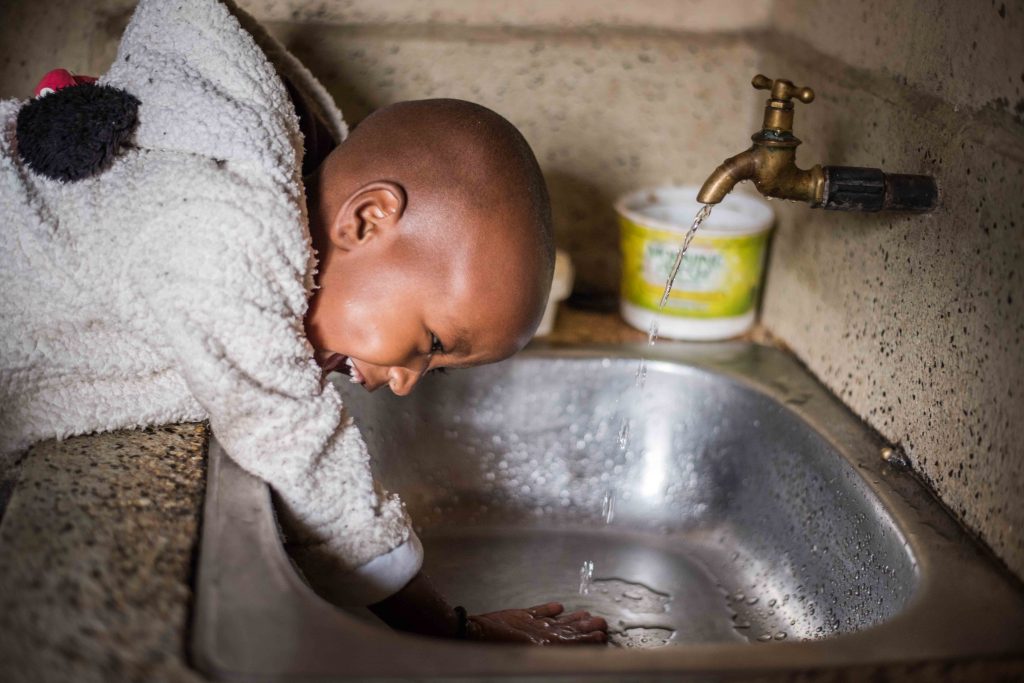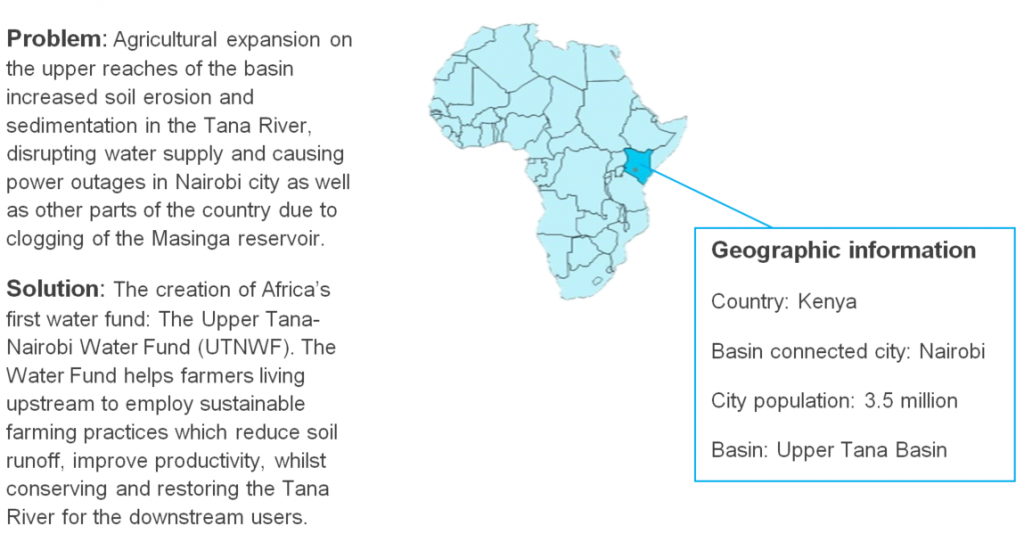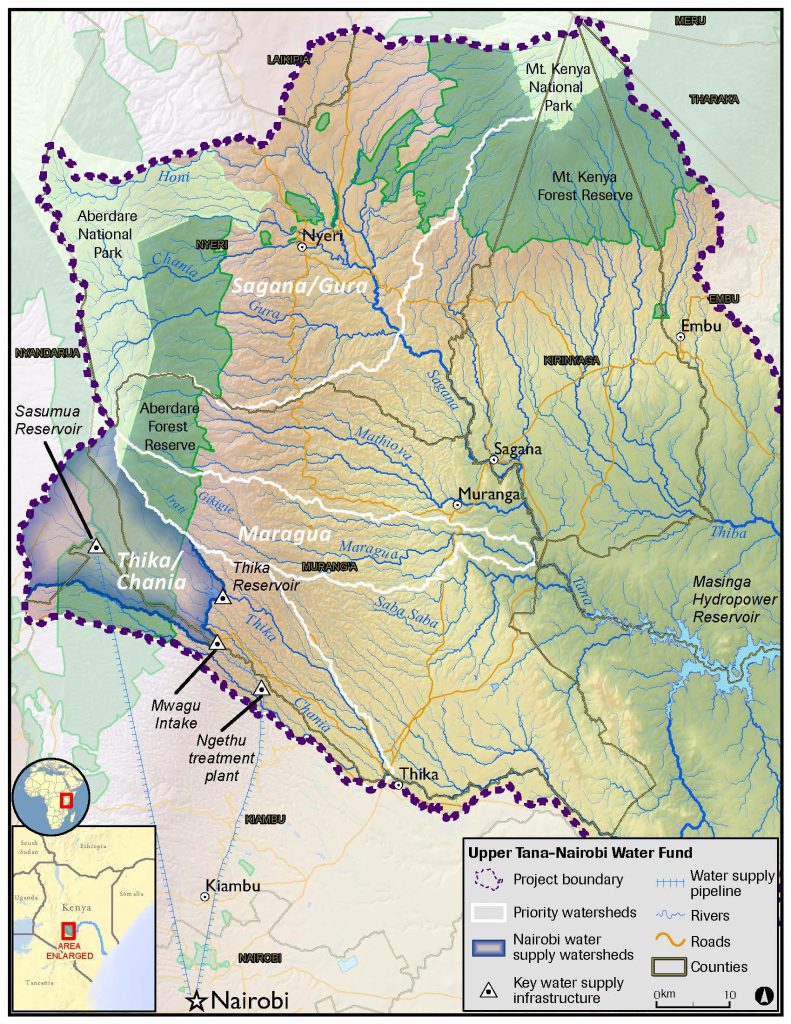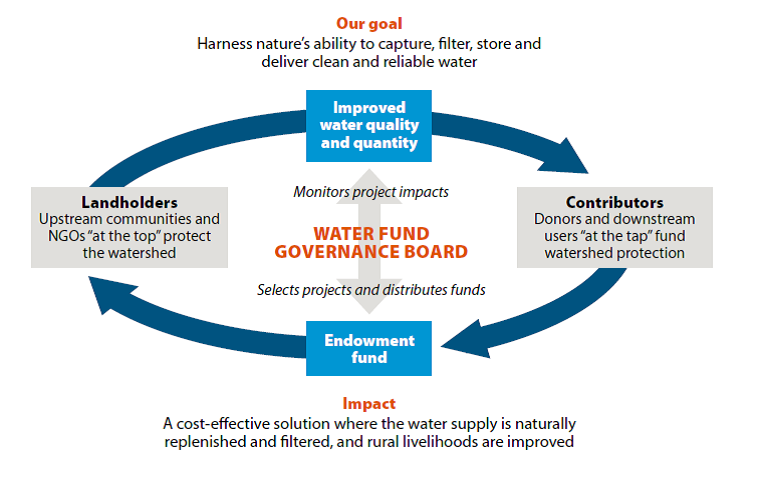Restoring water supply in Nairobi, Kenya’s capital
Nairobi, Kenya’s capital is the industrial and business centre of the country and consequently has a growing population, attracted by the prospects the city offers. A key challenge is ensuring the population has a steady supply of fresh water for their domestic and industrial needs.
Ninety five percent of Nairobi’s freshwater supply comes from the Tana River, which originates in the highlands above Nairobi. The highlands are home to more than 100,000 small holder farmers who rely on the river for irrigation water. Since the 1970s, due to agricultural activities on the upper reaches of the river, there has been increased abstraction and siltation, which inevitably impacted downstream communities, ecosystems and activities, including reduced water supply to Nairobi, hydropower generation and water quality.
In an effort to reverse the deteriorating condition of the river, an ambitious plan called the Upper Tana Nairobi Water Fund (UTNWF) was set up by The Nature Conservancy (TNC) TNC, in collaboration with the government and other partners to finance and educate the farmers upstream on sustainable farming practices. So far the initiative has translated to improved livelihoods for the farmers upstream, and increased water supply and improved water quality to Nairobi as well as the downstream communities and ecosystems.
1. The Problem
Tana River is Kenya’s longest river, originating in the central Kenya highlands. From its headwaters in Mount Kenya National Park and Aberdares National Park out to the delta, the Tana River begins and ends in forests and wetlands of national and global significance.
It supplies 95 percent of Nairobi’s water and 50 percent of the country’s electricity. The Upper Tana River Basin is one of the nation’s most productive agricultural areas. Since the 1970s, the Upper Tana River, flanked by more than 300,000 smallholder farms, has become increasingly polluted by sedimentation and the water levels have been reduced due to unsustainable abstraction. This has translated to increased water treatment costs, increased water rationing in Nairobi, and frequent power outages countrywide as well as reduced livelihood for the smallholder famers along the River.
Climate variability, population growth, economic growth and associated rises in food and electricity production are putting ever-greater pressure on the river. A management plan is essential to increase resiliency of the watershed to increase water security for Nairobi and the communities reliant on the Tana River and enhance resiliency in the face of climate change.
It was therefore necessary for a water management plan to improve resilience so as to increase water security for Nairobi and the communities reliant on the Tana River.
Securing this important source of freshwater and ensuring that the quality of the water remains suitable to sustain rich natural ecosystems and the growing water demand from Nairobi is paramount. With only 40 percent of Nairobi’s residents having access to reliable water supply. Improving water supply access meant creating greater access for millions.
2. The solution
2.1 The Water Fund concept – connecting cities with their basins
To help restore and conserve the Tana River, a water management plan known as the Upper Tana Nairobi Water Fund, was instituted to help protect the river’s watershed. A team of scientists from academia, government and NGOs led by The Nature Conservancy (TNC), came together under this project to determine the potential benefits and costs of conservation activities in the Tana watershed, with a focus on improving farming activities.
The premise behind the water funds is that it is cheaper to invest in protecting water at the source (upstream) than it is to address water problems when they occur downstream. What this means for the city of Nairobi is a shift from solely investing in grey infrastructure (water treatment plants and reservoirs) at the urban level to investing in green infrastructure. A restored watershed yields enhanced water storage capacity and improved water quality through natural filtration and retention of sediment. The UTNWF is bringing together major water consumers in Nairobi – companies and government agencies with a vested interest in high quality and reliable water supply – and creating linkages to non-urban communities.
Major water consumers are largely playing the role of investors, including supporting a newly launched endowment for the UTNWF, while non-urban communities are provided with training and incentives to support land conservation measures (See figure 2 for the description of a water fund concept). The Kenyan government joining in the effort, committed a substantial amount of money to the establishment of the UTNWF, reflecting high level commitment to the restoration and conservation of the Tana River.
2.2 Developing and implementing the Upper Tana-Nairobi Water Fund
TNC has been a key player in laying the groundwork and gathering the water fund partners. Partners contributing to/supporting the UTNWF have different roles to play; mainly steering committee partners who provide the guidance on goals and aims of the project, local implementation partners who oversee the conservation activities in the catchment and water fund supporting partners (donors). The water fund partners form the governance mechanism driving the water fund forward.
Other essential building blocks considered by the partners, when establishing the Upper Tana-Nairobi water fund included:
• Science based-decision making processes
• Conservation financing tools
• Capacity for deployment (implementation of conservation activities)
• Communication with partners, stakeholders, funders and the general public
An important early step was the creation of a strong business case to understand the biophysical characteristics of the watershed, to demonstrate impact assessments of different land conservation strategies, and to present a tailor-modelled impact assessment to the key stakeholders. Using state-of-the art planning and watershed modelling tools, the business case outlines the return on investment that funders can expect. It lays the groundwork for how benefits will be realised, specifies timeframes and guides the implementation process.
In planning for the UTNWF, the economic impact of different land conservation interventions were modelled for three key basin stakeholders: small-holder farmers; Nairobi City Water & Sewerage Company (NCWSC) and Kenya Electricity Generating Company (KenGen). Land conservation measures further upstream in collaboration with small-holder farmers were deemed to hold mutual benefits. For example, reduced soil erosion is projected to increase agricultural yields and to increase water quality further downstream towards Nairobi. Working with these farmers was therefore a priority if soil erosion was to be reduced.
To help meet conservation and restoration goals, the UTNWF identified vulnerable farm land (e.g. established on steep slopes or in riparian buffers) in the sub-watersheds from which much of Nairobi’s drinking water is derived and that contribute to Kenya’s main hydroelectric dams. To meet the governance goals, the recruitment of strong trustee and management boards to 3-year renewable terms, helped to maintain a steady and consistent management system. The board is empowered in decision-making and legally establishing the water fund as an independent non-profit entity. Awareness about the water fund has been raised locally and internationally via media (newspapers and electronic media), community outreach, marathon sponsorships, engagement of school groups, and participation in important international water forums, including making presentations.
3. Outcomes
3.1 Success of the Upper Tana-Nairobi Water Fund
Since its inception in 2015, the UTNWF has had tremendous impact in the basin. Through the work of the Water Fund there are currently 19,000 farmers engaging in soil and water-saving methods and sediment/pollutant reduction techniques such as rain-water harvesting, drip irrigation, terracing, planting permanent grass buffers along streams, and agroforestry, with a goal of reaching 50,000 by 2020. The UTNWF partners have been providing the farmers with the skills, training and resources needed to conserve water, reduce soil runoff and improve productivity.
Within the first three years, the Water Fund has been able to help 8500 coffee farmers earn Rainforest Alliance Certification for conservation measures. These efforts have translated to increased yields of over 40% for the farmers. Along this timeline, 80 km of riverine vegetation has been restored, and over one million trees have been planted in the watershed, with 65 schools actively engaged in conservation activities locally.
These activities have resulted in measurable benefit to water quality and quantity. Scientists estimate that several million more litres of water are available for Nairobi each day as a result of on-farm activities to retain soil and to reduce water extraction from the river. Monitoring has identified a decrease by over 15% in sedimentation, with World Health Organization turbidity standards achieved for the first time in July-September 2016.
3.2 Lessons learned from Upper Tana-Nairobi Fund
With baseline socio-economic and routine ecological monitoring in place, the partners have been able to identify areas needing improvement, as the next farms are targeted for training and implementation of conservation measures. For the next phase of the fund, it was agreed that intervention should focus on, the large proportion of sloping or steep land in the watershed that lacks soil conservation measures; the 50% of riparian buffer zones that are two metres or less in width; and activities that increase dry season water flows. The intent is to rapidly deploy training and resources, across 10,000 additional farms in order to meet the goals of the project.

Location: Pangani district in Nairobi. Jacinta Ng’ang’a, 60 years old, lives in a one bedroom/1 bathroom apartment with her husband and two adult children. Her 3 other children have moved out. She is a business woman selling soaps, tissue paper and clothes in whole sale. She gets running water 3 days a week (Friday, Saturday and Sunday) so she “harvests water”/refills all her jerry cans to last the week. Her kitchen and bathroom are full of water buckets, bottles and jerry cans. She often stores enough water to last a few weeks because they may not have running water for two weeks straight. Sometimes she has to purchase water at 20 litres/50shillings. Today Jane Wanjiku Njuguna (15 years old) and Nicole Wanjiku Njuguna (3 years old) are visiting their guardian/grandmother at her home. Photo credit: Roshni Lodhia – The Nature Conservancy.
3.3 Sustaining the Upper Tana-Nairobi Water Fund
With the successes of the UTNWF evident and the importance undeniable, scientists and field experts continue to work with farmers and community members to ensure that the conservation strategies continue to bear fruit. It is important to keep the momentum of the programme running. To achieve this, a Water Fund endowment has been established. The UTNWF board is working to promote and fundraise for the endowment, having thus far gathered seed capital of $1.35 million. Annual revenues from the endowment will be used to support ongoing operation of the Water Fund as well as implementation of upstream conservation activities. The UTNWF continues to reach out to additional stakeholders to help contribute to expansion of watershed conservation work in the interim. By and large, the UTNWF is a testament on how cooperation between different stakeholders, given the right material and intellectual support, can go a long way in restoring and conserving a watershed for improved water security for the benefit of a city such as Nairobi whilst improving livelihoods for non-urban communities.
Key Words
| Kenya | Nairobi | Partnership | Water quality |
| Community | River restoration | Ecosystems | |
| Water Fund | Economic instruments | Water Supply |





